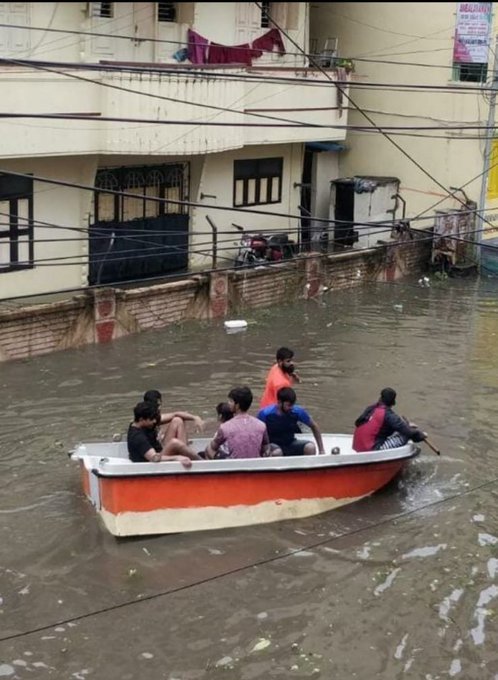Read in : தமிழ்
The DMK government has not yet moved into high gear on a comprehensive flood mitigation programme for Chennai and other Tamil Nadu cities, but it has received a fresh set of warnings from the Intergovernmental Panel on Climate Change (IPCC), about the likely paralysis that the State capital could face as the climate undergoes changes due to man-made greenhouse gas emissions.
Scientists who form part of the IPCC’s Assessment Report network, Working Group II, assert that a continued rise in the world’s average temperature compared to pre-industrial times, beyond 1.5 degrees C, will produce catastrophic effects for many regions, including productive land and prosperous cities. That includes Chennai.
The core of the message requires good policy from the State:
Transform
- the energy industry
- urban infrastructure
- rural infrastructure
- societal imperatives and behavioural change
Adopt
- ecosystem-based approaches to conserve and restore land and nature
Interestingly, the IPCC warning comes just as the India Meteorological Department (IMD) issued a weather alert for rare heavy rain this month, on March 4 and 5, in some southern coastal districts, the Delta region, Puducherry, Karaikal and moderate to heavy rain in Kallakurichi, Ariyalur, Perambalur and Tiruchi. The last time parts of the State got pounded by rain in March was in 2008, with severe disruption following. Flood and extreme weather have a high economic cost, as the IPCC points out.

Residents of a flooded Chennai locality being moved to dry areas by boat. (Photo: Twitter – En Chennai Nam Chennai)
Millions in distress
Tamil Nadu’s story is part of the overall mosaic weather system changes that are expected to occur in the coming years from climate change. According to the IPCC, the largest absolute number of people displaced by extreme weather in the world each year are in South, South East and East Asia ahead of sub-Saharan Africa. This trend poses a threat to the Zero Hunger goal under the UN Sustainable Development Goals (SDG 2) due to future disruption of food systems. This is certain to affect South Asia, the scientific body says.
Observational and other data used by the IPCC point to the intensity of heavy rain rising in many regions (high confidence), including much of North America, most of Europe, most of the Indian subcontinent, parts of northern and south-eastern Asia, much of southern South America, parts of southern Africa and parts of central, northern and western Australia (chapter 4 of report).
Chennai gets a prominent mention for the 2015 flood, although there is no evidence from observational analysis or global weather models that the risk was increased due to climate change. That is not the whole story, though.
Namma Chennai: a migration hotspot
The report cites Chennai as one of the cities, along with Chittagong, Dhaka and Mumbai, and the Gangetic Plain and the Delhi-Lahore corridor as a migration hotspot. These cities and regions will be “exposed to both climate change impacts and major migration destinations and amplified rural-urban migration”, it says.
There is a clear warning that Tamil Nadu policymakers cannot miss: the report makes an assessment that Chennai is among the 20 largest coastal cities in the world at risk for highest flood losses by 2050, and is among 13 in Asia.

Chennai Corporation undertaking flood relief work in Sholinganallur on November 13, 2021 (Photo: Twitter – Veera Raghava Rao IAS)
In another sharp observation, the report finds that planned relocation of people in Chennai, as part of risk reduction, actually put these populations in hazardous zones. These new areas were environmentally sensitive, had low livelihood opportunities and harboured new risks. The answer would be to boost inner city rental housing. Similarly, in Bengaluru, migrant populations faced risk of high flooding, insecure and unsafe livelihoods and social exclusion.
Considering the evidence on Mumbai, which will have a projected population of 2,73,43,000 by 2035, the report finds sufficient evidence for risk of flooding and sea-level rise due to climate change, though not for heat and urban heat island effect. Maharashtra should be concerned that its capital has not made significant progress on institutional and ecosystem metrics to meet the challenge. The infrastructure had made medium progress. Which brings up the question: has Tamil Nadu sufficiently raised its game on institutional and ecosystem parameters? An annual white paper on climate change measures could explain the progress.
India is among the frontline countries encountering Average Annual Loss from multiple natural hazards, which is calculated at $293 billion overall. These hazards include exposure to at least one of the following: cyclones, floods, droughts, earthquakes, landslides and volcanic eruptions. The Chennai flood of 2021 revived the water terror of 2015, and the focus is now on what the DMK government is ready to do in the next few years, and quickly too.
Chennai figures among the world’s second rung cities with a population between 5 million and 10 million (population put at 9.6 m) that are at high risk of disaster-related mortality.
Wanted: climate-resilient development
The IPCC’s 1.5 C-plus warning demands a comprehensive answer from the Tamil Nadu government.
Does it have the political will to reframe all policy and evaluate laws and rules solely on the basis of human health, wellbeing, equity and justice? Making Chennai and other parts of Tamil Nadu resilient calls for a Human Systems Transition for the energy industry, urban, rural infrastructure, and societal imperatives.
Fossil fuels will have to taper down, rooftop solar on each home and office has to get a massive policy boost, waste has to become a resource for materials recovery, and urban development has to depend on land, freshwater, coastal ecology and oceans to boost livelihoods, health and lower greenhouse gas emissions.
The IPCC has sounded another warning, with specific flags for Chennai, one of India’s premier cities. The onus is on the DMK government and Chief Minister M K Stalin to remove obstacles to green growth.
Read in : தமிழ்











